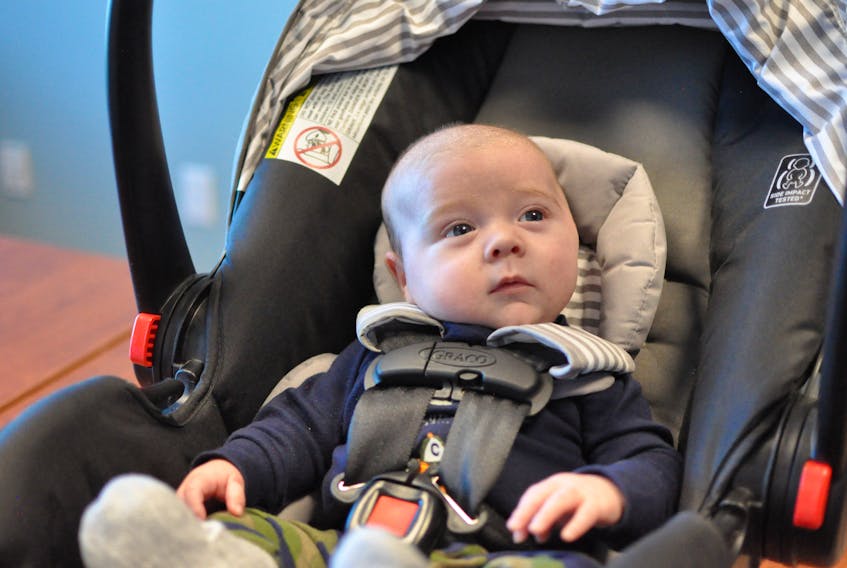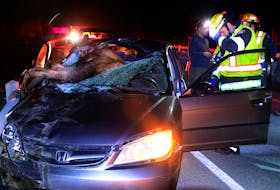CORNER BROOK, N.L. — One of the most important things any parent needs to consider when it comes to keeping their child safe is making sure their car seat is properly installed.
“And it seems a bit scary at first when you’re looking at the manual of how to put it in and your vehicle manual,” said Paula Matchim, program manager at the Family Outreach Resource Centre.
But parents can find help at the centre to make the experience not so scary. All staff are trained as car seat technicians through the Child Passenger Safety Association of Canada (CPSAC).
Matchim is also an instructor trainer.

On average the centre installs 70 to 80 car seats a year with between 10 to 15 completed at the centre’s monthly car seat clinics.
The centre held its most recent clinic on Sept. 13 in advance of Child Passenger Safety Week, Sept. 15-21. The association provided the centre with a grant for the clinic.
Matchim first trained as a car seat technician in 1999 and over the years has seen a lot of don’ts when it comes to car seat installation.
“I’ve seen seats with pieces of 2x4 underneath them to be levelled. I’ve seen seats strapped in with bungie cords.”
Times are changing with lot more information available, and the seats of today are easier to install with Universal Anchorage Systems now standard in all new cars, vans, light trucks and sport utility vehicles. But some mistakes are still being made.“A lot of times we see seats aren’t in tight enough,” said Matchim.
“I’ve seen seats with pieces of 2x4 underneath them to be levelled. I’ve seen seats strapped in with bungie cords.”
“You have to push down on the seat so it compresses the vehicle seat and then tighten the belt. So, then when you let go, when the seat comes back up that makes the belt that much tighter.”
Another common mistake is having the straps in the wrong position for the size of the child.
In infant seats the straps should be at or just below the child’s shoulders, but in forward-facing seats they should be at or above the child’s shoulders.
Matchim said the car seat technicians don’t just do the work for the parents, they show them how it’s done and get them to help.
That way if they have to move the seat or have another child they may feel comfortable installing the seat themselves and just need the centre staff to check it over.
Matchim also does sessions with maternity staff nurses at Western Memorial Regional Hospital who have a car seat checklist to go through with parents before they leave the hospital with their newborn.
Car seat technicians have to recertify every three years and instructor trainers every two years.
In between that time, they stay current by checking car seat recall lists before every clinic and by keeping up on information provided by the CPSAC on new seats and changes to legislation.
[email protected]
Twitter: WS_DianeCrocker
Car seat facts

Infant carriers
Babies should stay in a rear-facing infant carrier for as long as possible.
Some seats have a weight limit of 22 pounds, but others go up to 40 pounds, so parents should check the manual for their car seat.
At a minimum, they should remain in the carrier until they weigh 22 pounds and are able to walk unassisted, usually around one year of age.
The next stage
When it’s time to move into a bigger car seat some parents will buy one that can go in both the rear- and forward-facing positions.
That way a child can stay rear facing up to 40 pounds, or whatever the seat recommends as some go up to 60 pounds.
Booster seats
At 40 pounds a child can go into a booster seat.
In Newfoundland and Labrador, they must remain in a booster seat until they are 4 feet 9 inches tall, eight years of age and 80 pounds — and they have to meet all three criteria.
Booster seat regulations vary by province so it’s a good idea to check before travelling.
General rules
Forward facing seats must be are installed using the Universal Anchorage Systems and a tether strap attached to the tether bolt located in a vehicle.
A properly install seat should have no more than a half inch of movement from side to side and forward.
Source: Family Outreach Resource Centre, Corner Brook









